Visit the double monastery founded in the 12th century by S. Guglielmo and the Diocesan sanctuary of S. Luca. Experience the story of Guglielmo and the Abbey in the rooms of the multimedia area.
The abbey of Goleto as it was in the past
Admire the church by Vaccaro, faithfully rebuilt as it was in 1745 when it first opened!
Visit the GAM
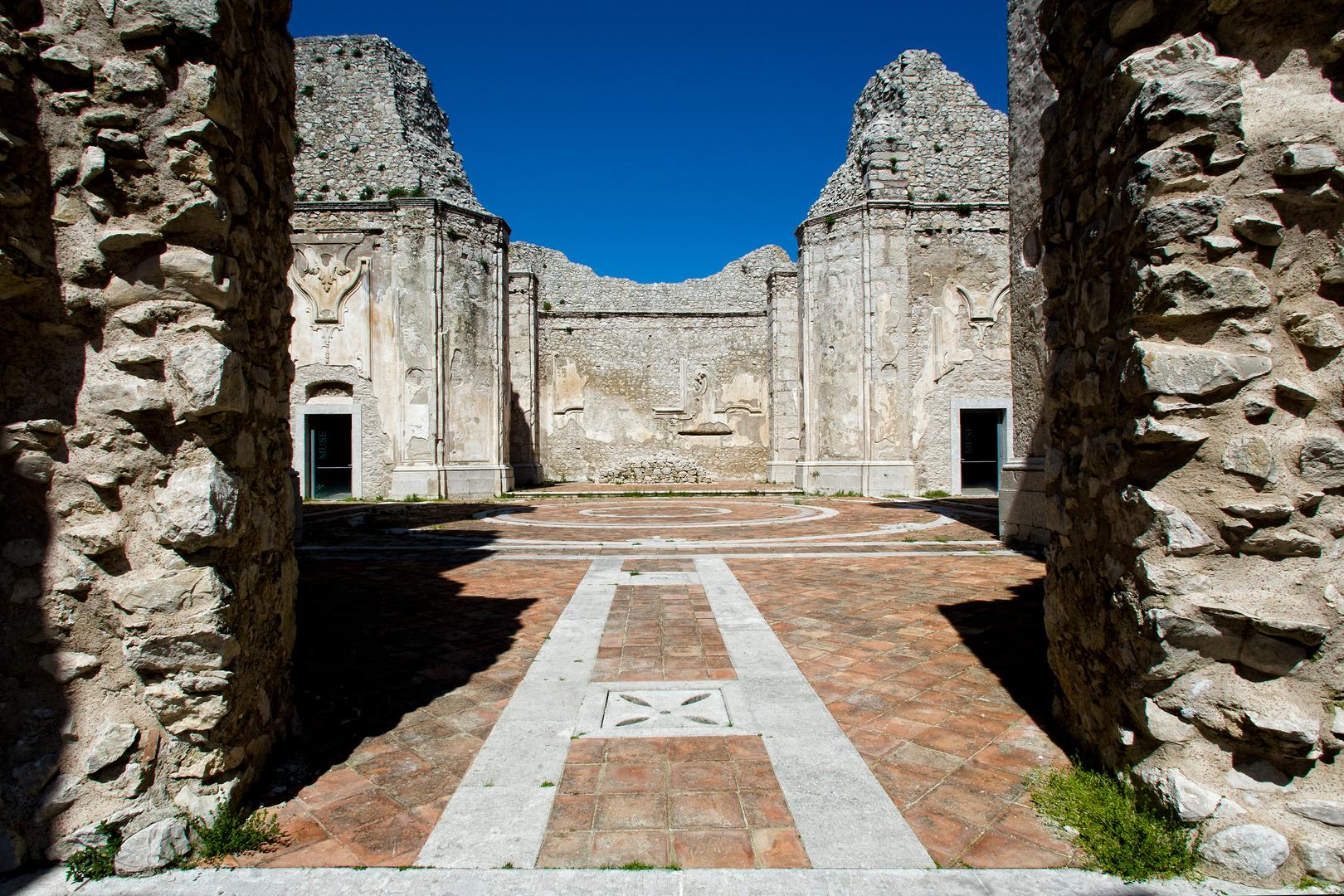
-
Hours
Saturdays, Sundays and Public Holidays
10:00–12:00 | 15:00–17:00On other days and for school groups - Visits available by prior telephone booking:
0827 24432 -
Ticket
€ 2.00
Guglielmo's Places
-
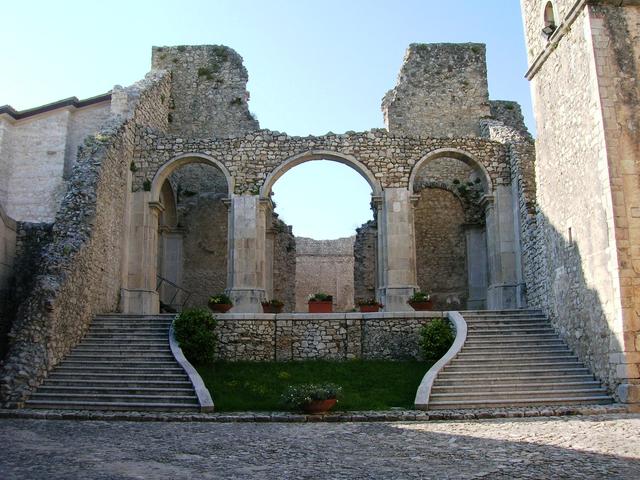
Abbazia del Goleto
Il Goleto is a rural area located at around 600 metres above sea level, near the sources of the Ofanto river, on the border between the municipalities of Sant’Angelo dei Lombardi, Nusco, and Lioni.
In the early 12th century, the young hermit Guglielmo, en route to the Holy Land after pilgrimages to Santiago de Compostela and Rome, followed the Via Appia and stopped in Irpinia, where he first founded the Abbey of Montevergine and later the monastic citadel of the Santissimo Salvatore here at Goleto, beginning in 1133. To build the latter, Guglielmo was granted a vast tract of land by Ruggero, the Norman lord of nearby Monticchio.
The complex was built largely using reclaimed materials from a pre-existing Roman settlement once owned by Marcus Paccius Marcellus. Flanking the original church rose an innovative ‘double monastery’, with two wings and two cloisters—the larger of which was reserved for the nuns. In this newly founded religious community, the supreme authority was held by the abbess, while the monks were entrusted with liturgical duties and manual labour.
Guglielmo never reached the Holy Land. He died in Irpinia, here at Goleto, on 24 June 1142. Eight hundred years after his death, in 1942, Pius XII proclaimed him Principal Patron of Irpinia.
-
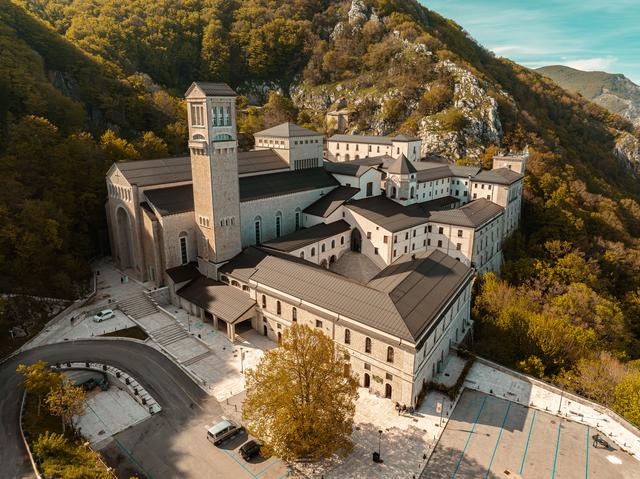
Montevergine
The Sanctuary of Montevergine stands in the heart of Irpinia. At an altitude of 1,263 metres, it overlooks the valley of the Sabato river. It is a place of deep spirituality and has been a pilgrimage destination for centuries.
The history of Montevergine is closely linked to Guglielmo da Vercelli, who founded and built it with his own hands in 1124, nine hundred years ago. Guglielmo was responsible for the construction of a church dedicated to the worship of the Madonna, which remains a pilgrimage site to this day, and for the foundation of the Verginian congregation.
The Abbey of Montevergine can be reached on foot (from Mercogliano or Ospedaletto, via the devotional path known as the Juta, which coincides with the Cammino di Guglielmo). A drivable road, with numerous narrow hairpin bends, connects the abbey with the Avellino Ovest motorway exit on the A3 Napoli-Bari.
We recommend ascending via the charming funicular railway, built in 1926 and inaugurated in 1956. Covering a distance of only 1,670 metres, it overcomes a height difference of 734 metres, with a gradient varying between 43 and 63 degrees. Departing from the centre of Mercogliano, it reaches the abbey in just 7 minutes, passing through chestnut woods and limestone outcrops, offering magnificent panoramic views over the valley and the Abbey of Loreto.
Connection with Saint Guglielmo and his miracles
From the Legenda della vita del Santo, we learn that the young Guglielmo, after arriving in Irpinia and stopping near Atripalda (Av), climbed the mountain above Mercogliano (Av) in 1118, choosing it as the ideal place to lead a solitary life and to create a refuge of peace and spirituality. There, near a spring and the ruins of a temple dedicated to the pagan goddess Cybele, Guglielmo built a small chapel dedicated to the Virgin Mary. It was near this chapel that Saint Guglielmo made his home.
Soon, his fame spread throughout the area, and many came to visit the holy hermit. Around him, on the Monte della Vergine, a community of God-seekers formed, to whom Guglielmo gave a Rule of life inspired by the Regula monasteriorum of Saint Benedict. The Congregation of the Monks of Montevergine quickly spread throughout southern Italy. Thus was born the largest and most important Marian sanctuary in southern Italy, where the Madonna di Montevergine, also known as Mamma Schiavona, is still venerated.
Montevergine is mentioned several times in the Legenda, which also recounts a number of miracles. These include the following episodes, as recorded in Episodes from the Life of Saint Guglielmo by Giovanni Mongelli O.S.B.: The bear that muddies the water, Construction of the first church, The episode of the Ligurian Gualtiero, The legend of the doves, The healing of a mute woman, and—certainly the most famous episode—The legend of the wolf and the little donkey.
-
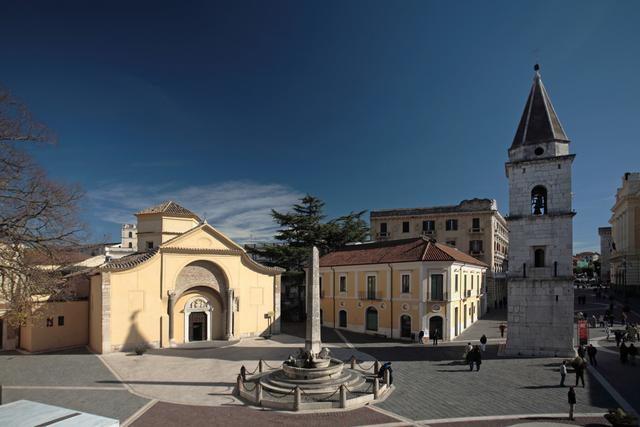
Benevento
Benevento is located in the Apennine hinterland of Campania, at an altitude of 135 metres, at the confluence of two rivers originating from Irpinia: the Calore and the Sabato. It has a population of around 55,000 inhabitants. In ancient south-central Italy, it was an important road junction.
In pre-Roman times, under the Oscan name Malventum, it was possibly the most significant settlement of the Samnite tribe of the Irpini. In 275 BC, following their victory over Pyrrhus, the Romans renamed it Beneventum, making it the first settlement of Roman colonists with Latin rights.
It was crossed by the Via Appia, and in 114 AD Trajan chose it as the starting point for the Via Traiana, an alternative route to the Appian Way leading to the ports of Puglia.
-
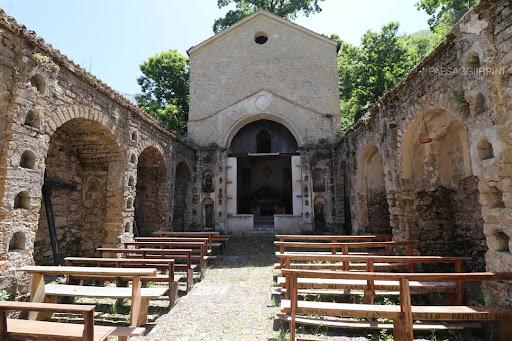
Chiusano di San Domenico
The municipality of Chiusano di San Domenico is situated on the slopes of Monte Tuoro, in the middle valley of the Calore river, at an altitude of 700 metres. It has a population of around 2,200 inhabitants. The etymology of the name likely derives from the Latin personal name Clasius, to which the suffix -anus was added; the addition San Domenico came later and does not refer to the town's patron saint, but rather to the saint to whom the church at the top of la Ripa is dedicated.
The foundation of the Hermitage of Santa Maria della Valle, also known as that of San Guglielmo, may date back to between 1128—the year in which Guglielmo left Montevergine—and before 1133, the year Goleto was founded. Today, the hermitage consists of two structures built in different periods and styles. The older part has a square base and is topped by a dome; the more recent part is open to the sky and is built like a single-nave church, with four round arches on each side. This section, dating back to the late 16th century, was constructed as a cemetery for the male and female members of the Confraternity of the Buona.
The complex was restored by the Superintendency of Salerno and Avellino following the damage caused by the 1980 earthquake. On the back wall of the small church is a fresco of the Madonna and Child, which can be dated to the first half of the sixteenth century. It reminds passers-by that: “Whoever turns to Her with pure and sincere faith, She is generous with graces and favours.”
-
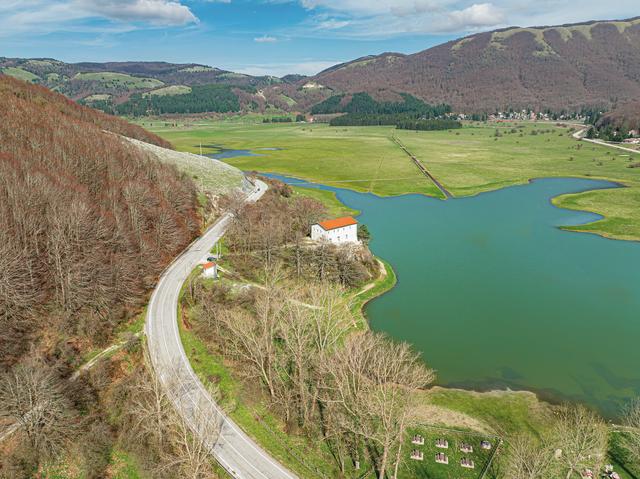
Lago Laceno
The Laceno Plateau, situated at around 1,000 metres above sea level, is an extraordinary natural area featuring a karst lake, a ski resort, and an extensive and well-maintained network of hiking trails. Numerous hotels and dining facilities are available in the area.
Points of interest include the Cave of San Guglielmo (the endpoint of Stage 4 of the Cammino), the karst lake itself, and the Caliendo caves (which require speleological equipment). Notable tourist facilities include the network of mountain trails, a horse-riding centre, and the chairlift that ascends Monte Rajamagra.
Laceno is well worth a longer stay, allowing visitors to enjoy, through guided excursions, the many wide-ranging views of the mountains surrounding the karst lake. Particularly noteworthy is Monte Cervialto (1,809 metres above sea level), the highest peak in the Monti Picentini range and the fourth tallest in the Campania region. From its summit, one can see both the Adriatic Sea (including Barletta and the Gargano) and the Tyrrhenian Sea (from Paestum to the Gulf of Naples).
-
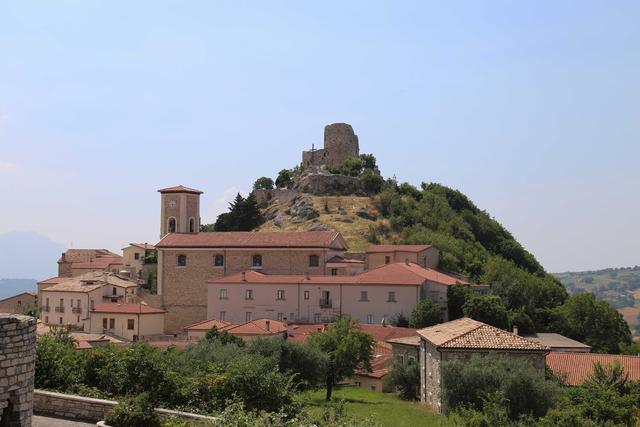
Rocca San Felice
The municipality of Rocca San Felice lies in the Ansanto Valley, near the sources of the small Fredane river, a tributary of the Calore. It is situated at an altitude of 750 metres and has a population of around 850 inhabitants. The castle, dating back to the 12th century and incorporating earlier defensive structures, can be seen from afar.
In the village, the small Civic Museum ‘Don Nicola Gambino’ displays artefacts ranging from prehistory to the Middle Ages.
The historic centre is well worth a visit, having been carefully restored after the 1980 earthquake. In the entrance square stands the old tree of liberty, planted by Napoleonic troops in the early 1800s following the French Revolution. At its base is a beautiful octagonal bench made from local stone.
A walk leads up to the Castle, perched on the rocky height, from which there are splendid views over the Fredane Valley. Not to be missed is the small but fascinating Civic Museum, where one can learn about the Xoanon—an archaic wooden cult sculpture discovered at the nearby site dedicated to the Goddess Mefite.
-
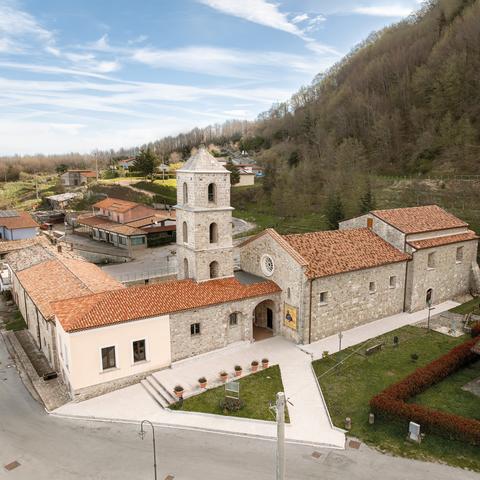
Pierno
Pierno is an inhabited hamlet of the municipality of San Fele (Pz), in Basilicata, situated on a small plateau at 960 metres above sea level. It is a mountainous, rocky area, rich in springs and chestnut woods. Here stands the beautiful Abbey of Santa Maria di Pierno, which, according to tradition, was founded by San Guglielmo da Vercelli around 1139, following the discovery—in a crevice of Monte Pierno—of a statue of the Madonna, previously hidden by Basilian hermits from nearby Monte Santa Croce.
The sanctuary was consecrated in 1221. Later, in 1456, after an earthquake, the statue of the Madonna was moved elsewhere, but then mysteriously disappeared, only to reappear once again in Pierno. Following this miraculous event, the church and adjoining convent were rebuilt. The interior, in Romanesque style, has three naves. The complex was restored after the damage caused by the 1980 earthquake.
-
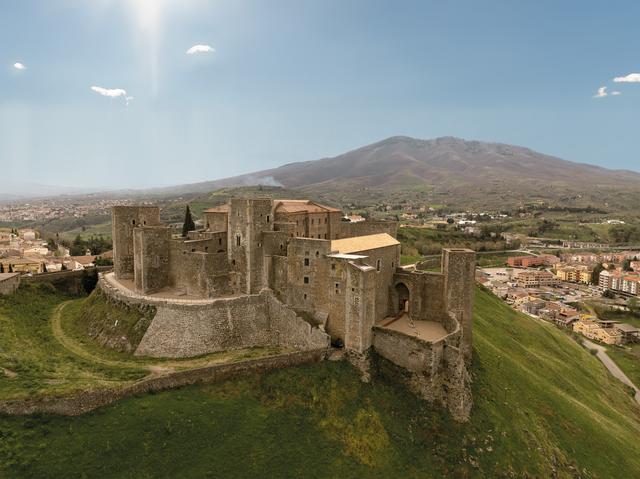
Melfi
On the northern slopes of the Vulture volcanic massif, in Basilicata, lies Melfi at an altitude of 530 metres, with a population of around 17,000. Positioned along the Via Appia, it overlooks southern Capitanata and the Terra di Bari. Founded by the Byzantines at the beginning of the 11th century, Melfi gained importance under Norman rule and came to be known as the “moral capital of the conquest of Apulia”, serving as the venue for key assemblies and synods. Alongside Venosa, Troia, and Salerno, it was one of the four ducales urbes of the Duchy of Apulia.
During the Norman-Swabian era, Melfi was the largest city in Basilicata, hosting communities of Amalfitan merchants and Jewish families. In 1153, King Roger II commissioned the bell tower of the cathedral in Melfi; with its sculpted lions—symbols of royal power—it was intended to urge the people towards obedience.
Frederick II frequently stayed in Melfi between 1230 and 1247. During the summer, when the Tavoliere plain became unbearably hot, the emperor often sought refuge here, enjoying the cool climate and the ideal surroundings for hunting. During his longest stay, from 26 May to 10 September 1231, the famous Constitutiones—commonly known as the Constitutions of Melfi—were drafted and promulgated. These represented a synthesis of the legal cultures of the Norman-Swabian period and became the legislative code of the Kingdom of Sicily.
Regarding the Castle, Frederick II reinforced the pre-existing Norman structure (which now houses the National Archaeological Museum) and added three new towers: the Marcangione Tower, the Tower of the Four Winds, and the small ‘Parvula’ turret.
-
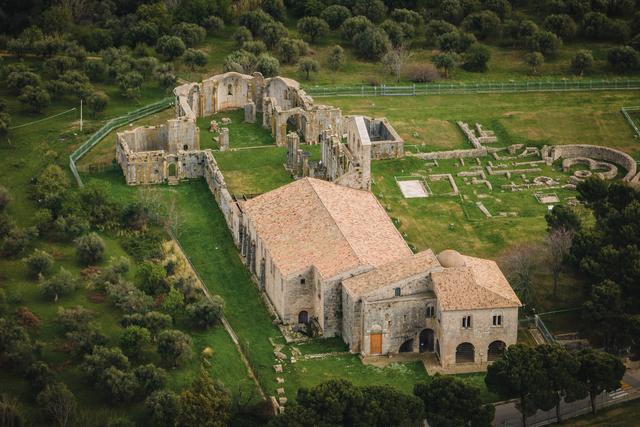
Venosa
Venusia, founded on the border between Apulia and Lucania, sits at an altitude of 415 metres and has around 12,000 inhabitants. It is a city with deep historical roots, but it is best known thanks to Horace and the Via Appia. It was occupied by the Romans in 291 BC following their victory over the Samnites. After the Battle of Cannae in 217 BC, the defeated Terentius Varro took refuge there. The city flourished throughout the Roman Empire, only to be sacked by the Saracens in the 9th century. After the Norman conquest, it regained its former military significance.
Venusia boasts a long and fascinating history, as shown by its small historic centre and the surrounding archaeological sites—among them Notarchirico, where the femur of a specimen of Homo erectus, who lived around 300,000 years ago, was discovered.
The archaeological park, located just outside the town, preserves the remains of the ancient Roman colony of Venusia, situated along the Via Appia. The colony was established on a site already inhabited by Apulian communities and is renowned as the birthplace of the illustrious Latin poet Horace.
-
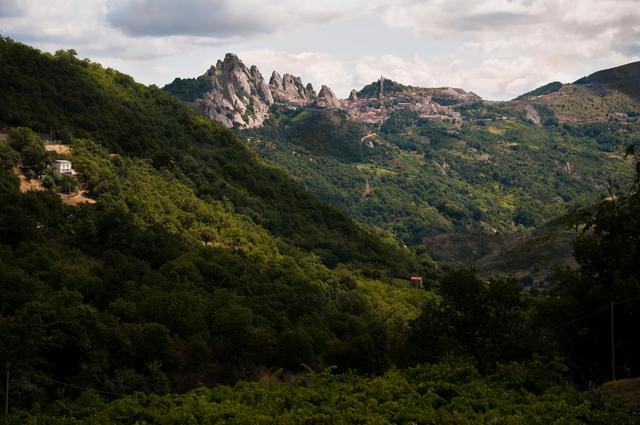
Monte Cognato
In the heart of Basilicata, spanning almost 30,000 hectares across the provinces of Potenza and Matera, lies the Gallipoli Cognato Piccole Dolomiti Lucane Regional Natural Park. Established in 1997, it is best known for its spectacular sharp dolomitic formations, upon which historic centres cling—most notably those of Castelmezzano and Pietrapertosa, connected by the famous ‘Flight of the Angel’.
The park’s area is almost entirely covered by the Gallipoli Cognato Forest and the Montepiano Wood, which is home to majestic specimens of Turkey oak, fragrant linden trees, wild pear and apple trees, maples, alders, and the rare holly. At lower altitudes, Mediterranean scrubland prevails. In spring, visitors are enchanted by the striking display of blooming cyclamens, anemones, and violets.
The variety of vegetation in the Gallipoli Cognato Regional Park is matched by a diversity of wildlife species. In addition to mammals such as wolves, badgers, porcupines, wildcats, and wild boar, the park is home to amphibians including the Italian newt and the spectacled salamander. The black stork nests here, and it is common to observe several large birds of prey in flight, such as the peregrine falcon, buzzard, and kite.
In the Legenda della vita del santo Guglielmo, there are numerous references to places and miracles, especially connected to Monte Cognato. Present-day toponymic traces lead us to the territory of the Gallipoli Cognato Piccole Dolomiti Lucane Regional Park in Basilicata; in particular, at Palazzo, in the municipality of Accettura (Mt), high in the woods of Gallipoli Cognato, important remains and settings of an 11th-century Basilian monastic settlement can be found, which later passed to the Benedictine nuns. According to the park’s description, around 1123 this place hosted Saint Guglielmo. Here, at Gallipolis (Accettura), he founded a church (Santa Chiara) and the adjoining Monastery of S. Maria di Serracognata, which later came under the Clarisse order. Subsequently, after the unification of Italy, the complex passed into state ownership. The old monastery garden now houses the botanical garden.
Virtual library
Our digital library offers a wide range of publications dedicated to San Guglielmo, the Abbey of Goleto, and the historical and cultural context of Irpinia.
The catalogue includes a large collection of digitised publications, available online or via the interactive touch station in the educational lab within the abbey’s multimedia area, where a rich historical photo archive and biographical videos on the life of Guglielmo are also available.